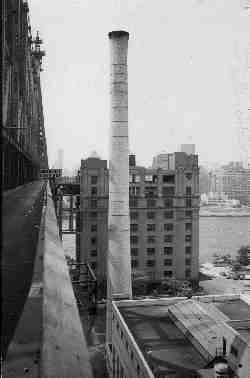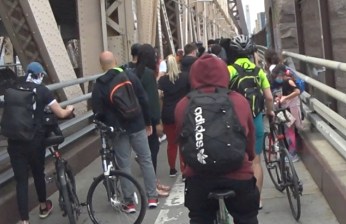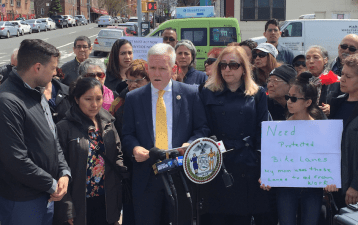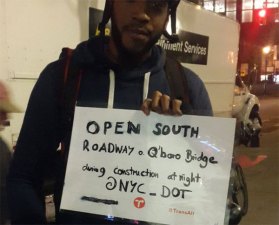Roosevelt Island Residents Want Pedestrian Access to QBB

Roosevelt Island’s old connection to the Queensboro Bridge — elevator building, 1916-1956
On Wednesday, Community Board 8 in Manhattan unanimously approved a proposal for conducting a feasibility study to physically connect Roosevelt Island to the Queensboro Bridge pedestrian and bike path. The proposal was put forth by Ellen Polivy of the Roosevelt Island Residents Association (RIRA) and the Roosevelt Island Community Emergency Response Team (CERT). She made a compelling presentation to Community Board 8’s transportation committee, citing the numerous benefits of the link from a public health, environmental and emergency preparedness perspective.
This is not a new concept. There used to be electric trolleys going over the Queensboro bridge and there was a stop at Roosevelt Island halfway across the bridge. People would then walk across to a building (see above photo of the Roosevelt Island elevator building) that had a number of elevators. These elevators were so big that they could fit the trucks and automobiles that supplied the island.
As recently as August 2004, Roosevelt Island residents faced what they refer to as "the perfect storm" of transportation problems (from a recent NY Times article – Times Select only)
…for a brief time, Roosevelt Island was cut off from the city that surrounds it.
All the means of access to the sliver-shaped island were out of service for about an hour that day, Aug. 12. The tram was down for a periodic tune-up. The Roosevelt Island Bridge, which lifts to allow boat traffic to pass through, was stuck in the open position. Electrical problems temporarily halted service on the F train.
However, the Department of Transportation is not considering the pedestrian-access proposal at this time. They cite security risks, the landmark status of the bridge and the need to maximize the flow of vehicles into Manhattan.
Kay Sarlin, a spokeswoman for the city Department of Transportation, raised doubts about a passageway that would have to be nearly 135 feet high.
”It’s not feasible,” she said. ”They’d have to remove a lane of traffic to put in an elevator.”
With an average of about 180,000 vehicle crossings a day, the Queensboro is one of the city’s busiest bridges, and according to Ms. Sarlin, eliminating a lane for an elevator would hamper traffic. A stairway could not be installed because people with disabilities could not use it, she added, noting that such a change would also cause security problems. Further, she said, since the facade of the bridge has landmark status, altering it would present a problem.
Let’s take each of these criticisms and see if they make any sense.
Security Risk: Here’s an island with a projected population of 15,000-20,000 in the next few years, on an island that lacks a permanent pedestrian link to the rest of the city. In fact, the main emergency route of escape for residents, the lift bridge to Queens, is often closed in light of security risks to the UN when that body is in session or hosts major events and shipping traffic is routed to the eastern side of Roosevelt Island. In the case of a Category 3 hurricane hitting NYC, the whole island would need to be evacuated, and officials have not provided details of the escape plan to the CERT or the RIRA. It’s a security risk for there to be no permanent link to the rest of the city.
Landmark Status: While it’s great that the Queensboro Bridge has achieved landmark status, this status should not override legitimate security and public health priorities. Rather it should ensure that any alteration harmonizes with the structure’s aesthetics — you know, the way the building that connected the island to the bridge for four decades did.
Removing a Lane of the QBB Would be Bad: This assumes that maximum flow of automobiles into Manhattan would be a good thing, when in fact we know that the current design generates dangerous conditions for pedestrians and cyclists on the Manhattan side of the bridge. Even specific requests for action from the local City Councilmember Jessica Lappin have so far not resulted any safety improvements by the DOT. Never mind that we might just want fewer cars to be able to enter the Central Business District for environmental and public health reasons.
When asked about why the Community Board supported the proposal, David Liston, CB8 Chair wrote via email:
"We passed a resolution asking the City to look into the feasibility of
providing another means of access to and from the Island by pedestrians
and the physically challenged."
"The feasibility study we’re asking the city to undertake would identify
a variety of means of egress/ingress between Roosevelt Island and
Manhattan and Queens. One suggestion was to look into a method
utilizing the Queensboro Bridge — making Manhattan accessible to
Roosevelt Islanders on foot and those using mobility assistance devices."
"Making all parts of the borough accessible to all is a worthy goal and one the Community Board fully supports."
With the Community Board now unanimously supporting a feasibility study, it will be up to the new DOT Commissioner to reconsider this proposal.


